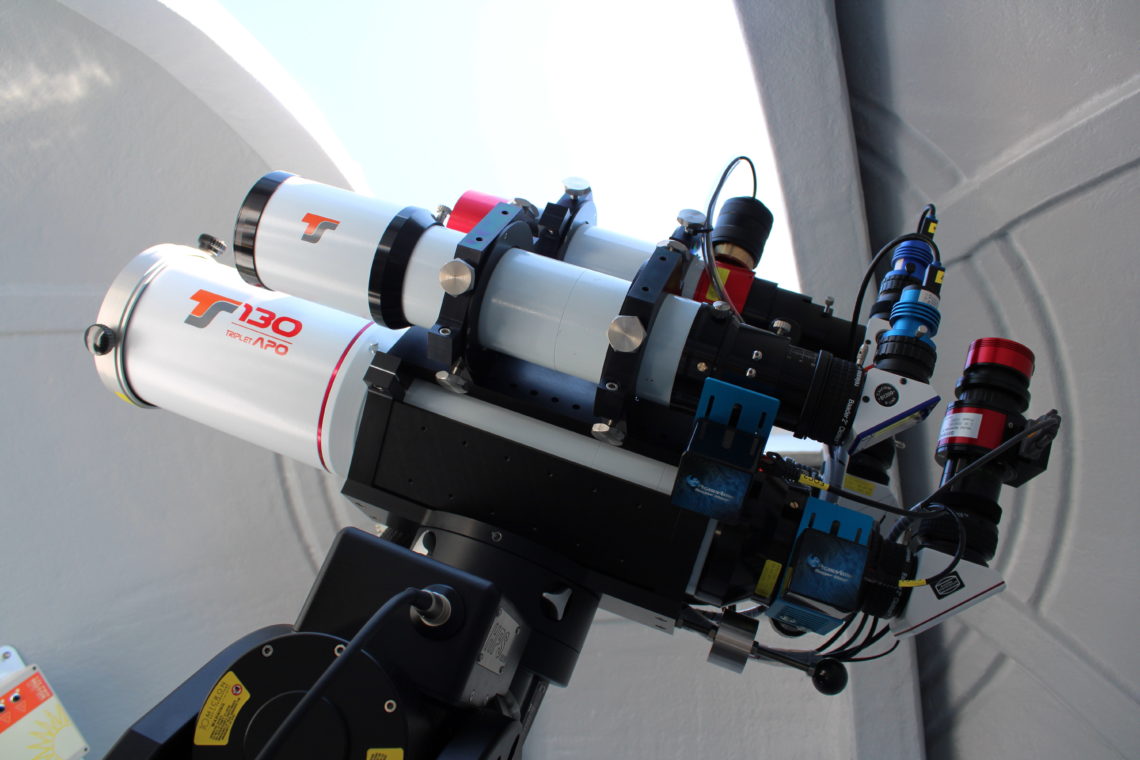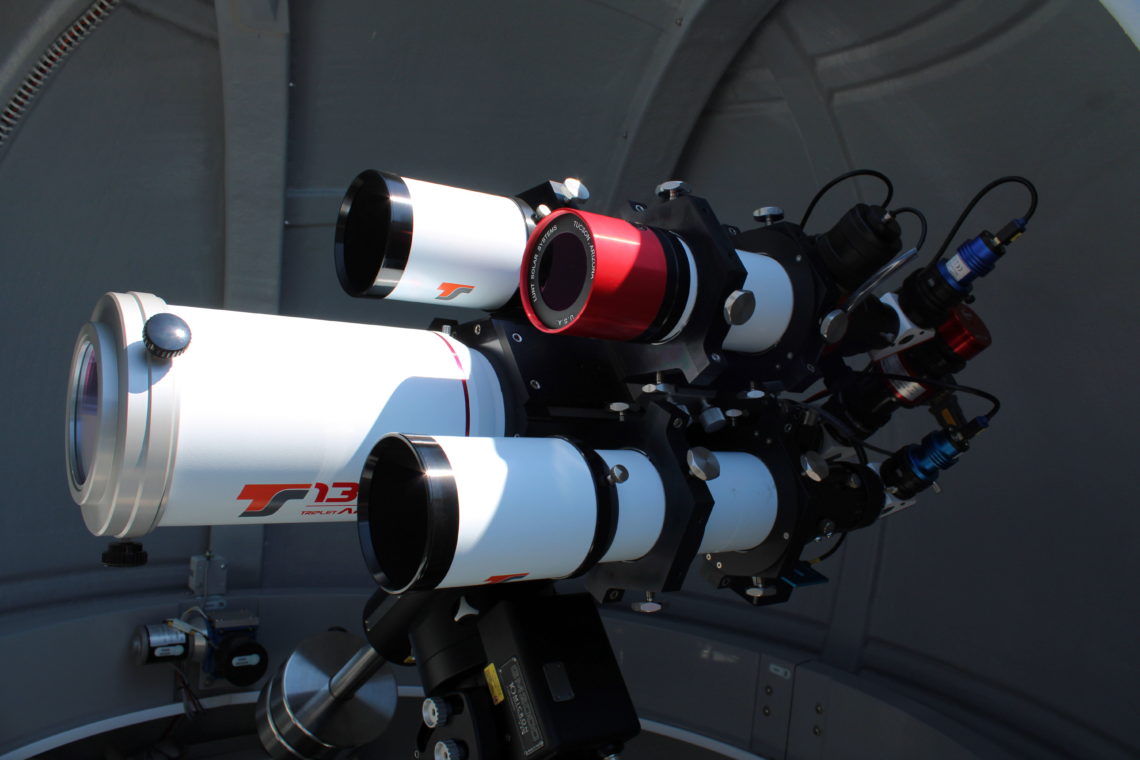The dome on top of the Uhrturm houses a versatile setup with several telescopes riding on the same mount, an 10micron GM 2000 HPSII equatorial mount. This mount accurately compensates the earth rotation with high accuracy and allows us to point the specific objects in the sky with high precision. The dome tracks the motion of the mount, so that the telescopes have a clear view through the dome slit. Depending on the time of year we use different telescope configurations.
Summer Setup
For the summer month our focus is on solar observations in different wavelengths to extract complementary information of the state of the solar atmosphere (photosphere and chromosphere). Therefore, our summer setup consists of a array of four telescopes equipped with different specialized solar filters working at different resolutions:
- H-α High Resolution: TS 130/860 Triplet APO with a Baader Energy-Rejection Filter and a Daystar Quantum Hydrogen-α Filter and a ASI 174m camera.
- H-α Full Disk: Lunt LS60THA Hydrogen-α telescope with LS60FHA double-stacking filter and a QHY 5III 178 camera.
- Ca-K Full Disk: TS 80/500 Triplet APO with a Lunt Calcium-K B1200 Module and QHY 5III 178 camera.
- White-Light Full Disk: TS 80/500 Triplet APO with Baader 2″ Herschel Wedge and Solar Continuum filter and QHY 5III 178 camera.
All four telescopes can be operated simultaneously. The three full-disk telescopes provide images of identical size and resolution. They are ideal to provide a comprehensive “picture” of the sun in three characteristic wavelength on a semi-automatic basis. Their cameras generate sequences of a few hundred images at a rate of 50 frames per seconds at a angular resolution of 1″ per pixel, which will go through a fully automatic image processing pipeline. For each sequence a post-processed image will be uploaded automatically to the web page in real-time.
The high-resolution H-α telescope is equipped with a research-grade filter with a bandpass of 0.5Å and a super-fast camera that will provide 120 frames per second with a resolution of 0.35″ per pixel. With this telescope we can zoom into active regions on the solar surface or limb (e.g. filaments and prominences) that were identified in the full-disk images. We can study these features with high spatial, temporal, and spectral resolution.
For the occasional night-time observation the TS 130/860 Triplet APO and the TS 80/500 Triplet APO can be reconfigured with cooled cameras and narrow-band filters or even a spectrograph.
Winter Setup
From October to February the sun is very low (< 25º altitude above horizon) and will not rise above the glass walls around the observatory – atmospheric disturbances at such low altitudes make decent observations very difficult in any case. Therefore, our focus during the winter months will be on night-time observations. We will reconfigure the telescope array for this purpose an replace the solar filters with dedicated deep-sky instruments:
- Spectroscopy: TS 130/860 Triplet APO with Baader DADOS Spectrograph and ASI 1600mm Pro Camera.
- High-Resolution Narrowband Imaging: TS 130/860 Triplet APO with Field Flattener and ATIK One 9.0 Camera.
- Wide-Field Narrowband Imaging: TS 80/500 Triplet APO with TS 0.79 Reducer and ASI 1600mm Pro Camera.
- Lunar and Planetary High-Resolution Imaging: TS 130/860 Triplet APO with fast Color Camera.
We will employ different observational techniques: spectroscopy of bright objects and narrowband imaging of emission nebulae. These techniques are less affected by light pollution and can provide meaningful scientific data even under city skies.
The spectroscopy telescope is equipped with a Baader DADOS slit spectrograph with a ASI 120mm camera for guiding and an ASI 1600mm Pro for recording the spectrum. With a low-dispersion grating it can record the full visible spectrum up into the near-infrared regime, a high-dispersion grating maps out a 150 nm window of the spectrum with higher spectral resolution.
Two of the instruments can be equipped for narrowband imaging at different resolutions and fields of view. The wide-field setup gives a field of view of about 5 full-moon diameters at a resolution of 2″ per pixel. The high-resolution setup has only 1.5 full-moon diameters at 0.9″ per pixel. Both instruments can take data of the same region in the sky simultaneously.
Alternatively, the larger refractor can be equipped with a fast planetary camera and focal-length extenders to image planets or the moon at high resolution using lucky-imaging techniques.



